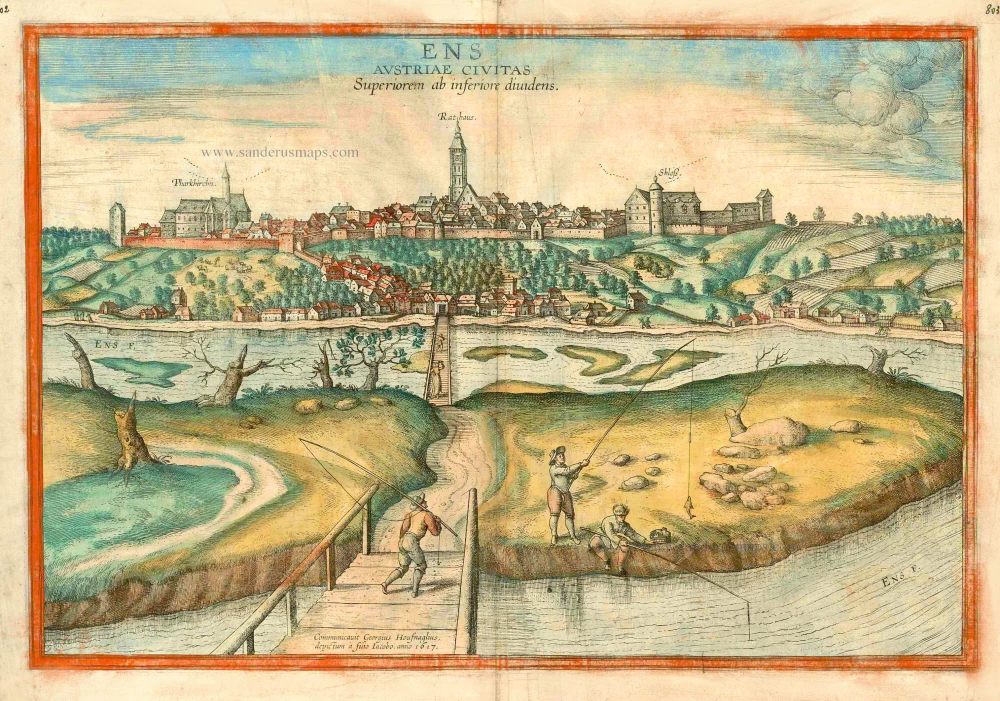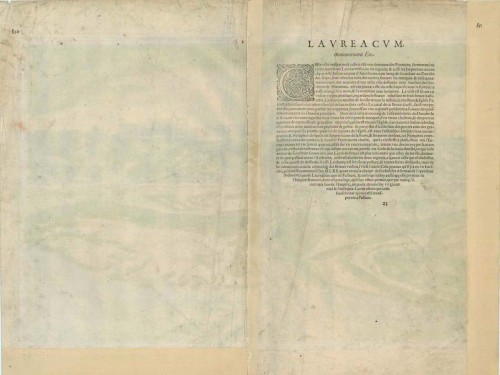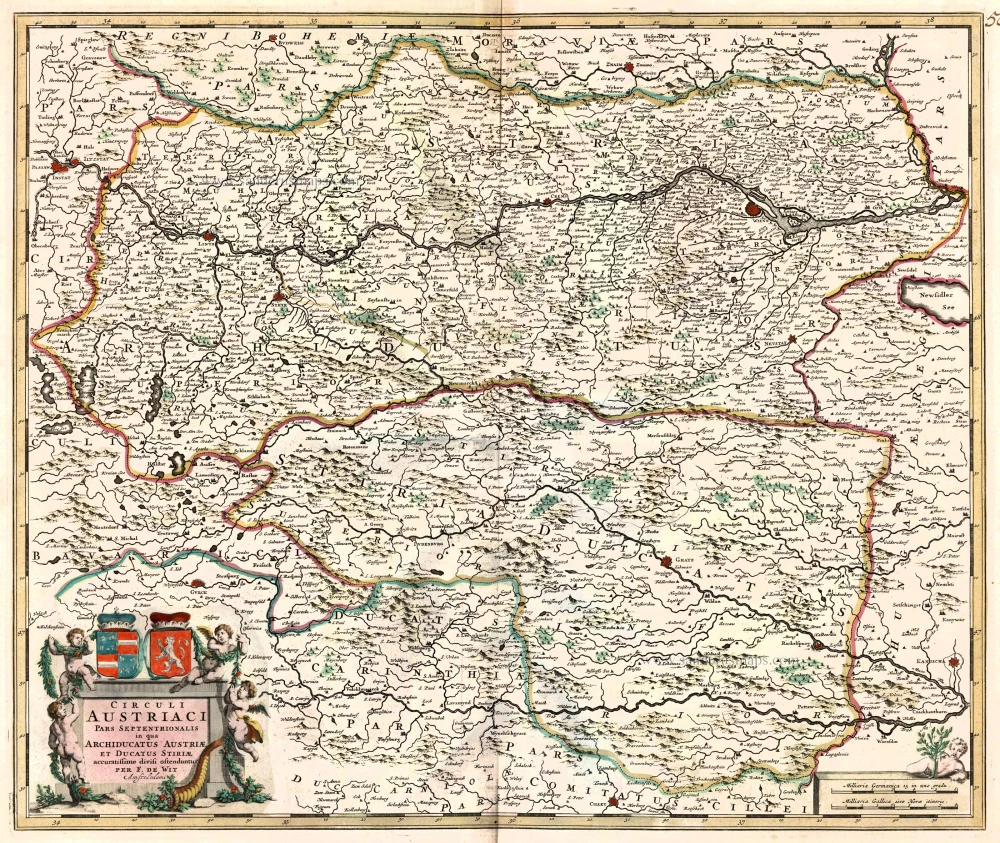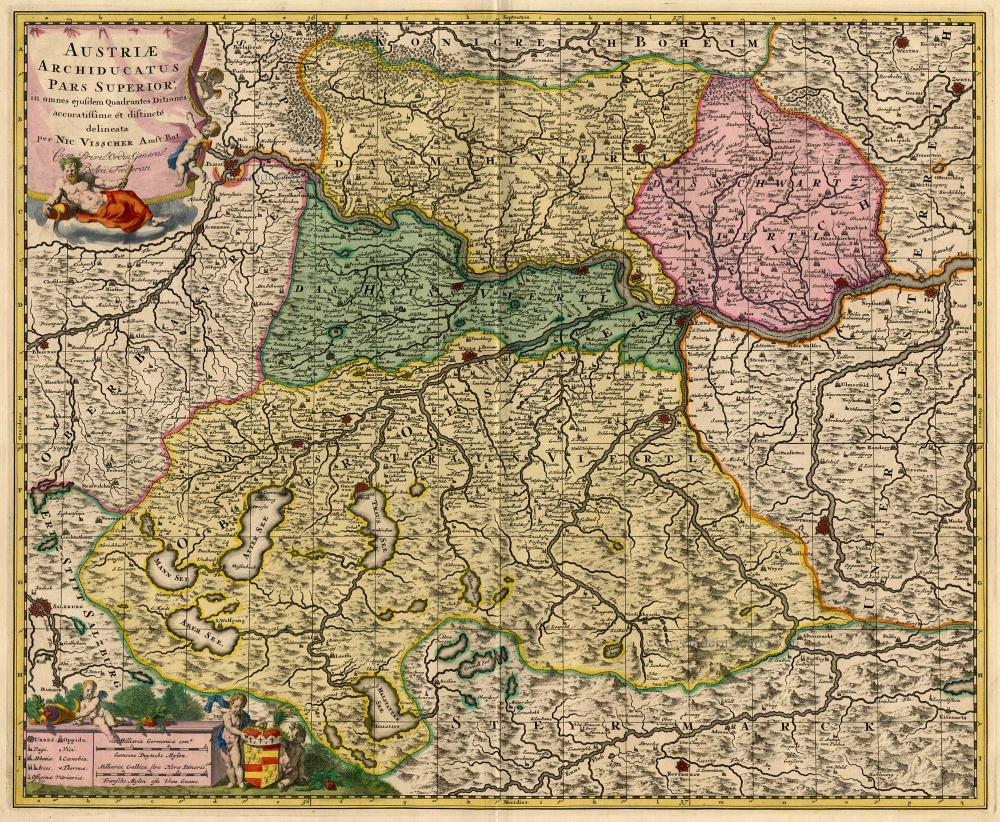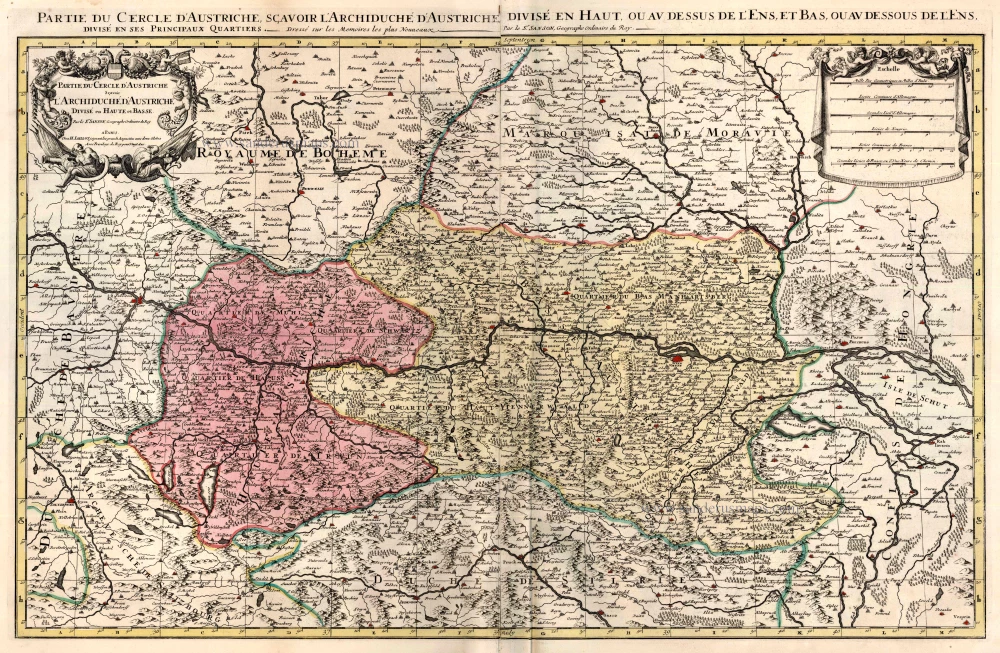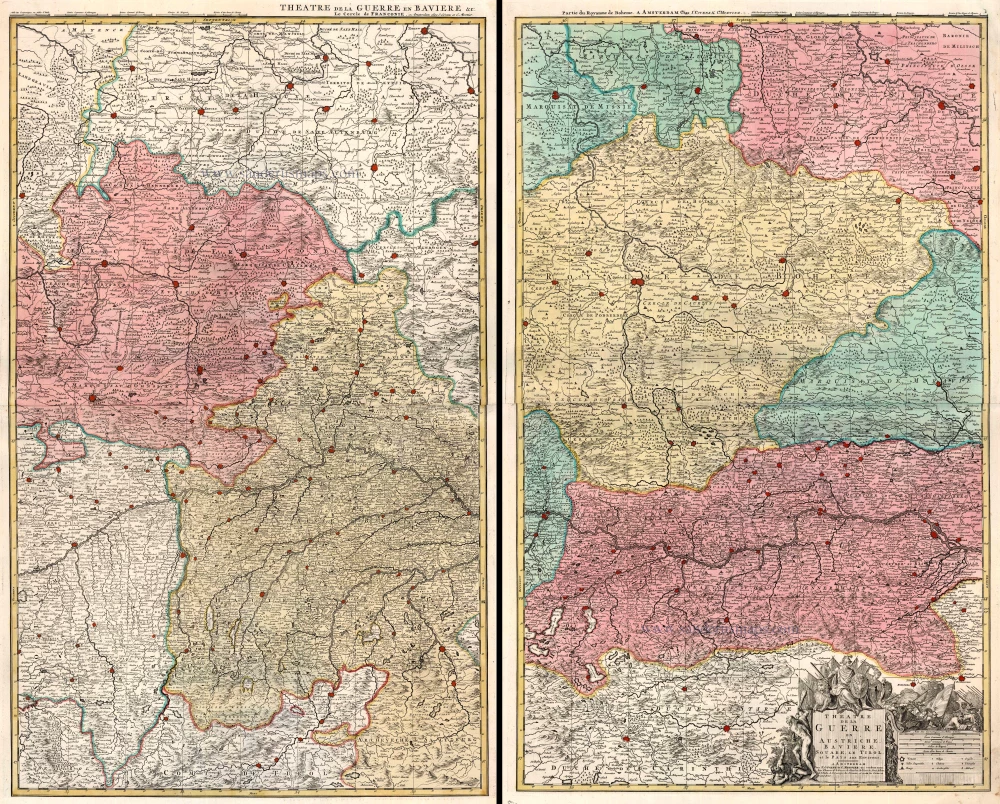Enns by Braun and Hogenberg. c. 1625
TRANSLATION OF CAPTION: Enns, a town in Austria, dividing Upper and Lower Austria. Signed and dated bottom : Procured by Georg Hoefnagel, painted by his son Jakob in the year 1617.
COMMENTARY BY BRAUN (on verso): "This was once a large, splendid city where the Romans had their colonies and permanent camp, and which they called Aureliana Laureacensis. And not only legions, but also the imperators and emperors themselves stayed here. It was destroyed so often and to such a great extent by the Goths, Huns and other barbaric peoples that scarcely any sign of its former splendour remains."
This is a frontal view towards the west of the town of Enns, which stands in the background on a hill above the river of the same name, surrounded by fields. On the left is the church of St Mary; on the right the castle dating from the 10th century, which developed into yhe palace of Ennsegg in the 16th century. The view is dominated by the 16th-century tower beside the town hall; the latter was rebuilt in 1547. Enns developed from a settlement that grew up in the 10-century next to the castle and received a municipal charter in 1212. In the immediate vicinity, on the site of the present-day district of Lorch, was once the Roman settlement of Lauriacum, which was granted city privileges by Emperor Caracalla in AD 212 and was destroyed by the Huns in the 5th century. (Taschen)
Braun G. & Hogenberg F. and the Civitates Orbis Terrarum.
The Civitates Orbis Terrarum, also known as the 'Braun & Hogenberg', is a six-volume town atlas and the most excellent book of town views and plans ever published: 363 engravings, sometimes beautifully coloured. It was one of the best-selling works in the last quarter of the 16th century. Georg Braun, a skilled writer, wrote the text accompanying the plans and views on the verso. Many plates were engraved after the original drawings of a professional artist, Joris Hoefnagel (1542-1600). The first volume was published in Latin in 1572 and the sixth in 1617. Frans Hogenberg, a talented engraver, created the tables for volumes I through IV, and Simon van den Neuwel made those for volumes V and VI. Other contributors were cartographers Daniel Freese and Heinrich Rantzau, who provided valuable geographical information. Works by Jacob van Deventer, Sebastian Münster, and Johannes Stumpf were also used as references. Translations appeared in German and French, making the atlas accessible to a broader audience.
Since its original publication of volume 1 in 1572, the Civitates Orbis Terrarum has left an indelible mark on the history of cartography. Seven more editions followed the first volume in 1575, 1577, 1582, 1588, 1593, 1599, and 1612. Vol.2, initially released in 1575, saw subsequent editions in 1597 and 1612. The subsequent volumes, each a treasure trove of historical insights, graced the world in 1581, 1588, 1593, 1599, and 1606. The German translation of the first volume, a testament to its widespread appeal, debuted in 1574, followed by the French edition in 1575.
Several printers were involved: Theodor Graminaeus, Heinrich von Aich, Gottfried von Kempen, Johannis Sinniger, Bertram Buchholtz, and Peter von Brachel, all of whom worked in Cologne.
Georg Braun (1541-1622)
Georg Braun, the author of the text accompanying the plans and views in the Civitates Orbis Terrarum, was born in Cologne in 1541. After his studies in Cologne, he entered the Jesuit Order as a novice, indicating his commitment to learning and intellectual pursuits. In 1561, he obtained his bachelor's degree; in 1562, he received his Magister Artium, further demonstrating his academic achievements. Although he left the Jesuit Order, he continued his studies in theology, gaining a licentiate in theology. His theological background likely influenced the content and tone of the text in the Civitates Orbis Terrarum, adding a unique perspective to the work.
Frans Hogenberg (1535-1590)
Frans Hogenberg was a Flemish and German painter, engraver, and mapmaker. He was born in Mechelen as the son of Nicolaas Hogenberg.
By the end of the 1560s, Frans Hogenberg was employed upon Abraham Ortelius's Theatrum Orbis Terrarum, published in 1570; he is named an engraver of numerous maps. In 1568, he was banned from Antwerp by the Duke of Alva and travelled to London, where he stayed a few years before emigrating to Cologne. He immediately embarked on his two most important works, the Civitates, published in 1572 and the Geschichtsblätter, which appeared in several series from 1569 until about 1587.
Thanks to large-scale projects like the Geschichtsblätter and the Civitates, Hogenberg's social circumstances improved with each passing year. He died as a wealthy man in Cologne in 1590.
Ens Austriae Civitas Superiorem ab inferioris dividens.
Item Number: 16363 Authenticity Guarantee
Category: Antique maps > Europe > Austria
Old, antique bird’s-eye view plan of Enns by Braun and Hogenberg.
Title: Ens Austriae Civitas Superiorem ab inferioris dividens.
Date of the first edition: 1617.
Date of this map: c. 1625.
Copper engraving, printed on paper.
Size (not including margins): 333 x 490mm (13.11 x 19.29 inches).
Verso: French text.
Condition: Original coloured, margins smudged, some bleeding of the orange colour.
Condition Rating: B.
From: Théatre des Principales Villes de tout l'Univers Vol. VI. c. 1625. (Van der Krogt 4, 41:3.6)
TRANSLATION OF CAPTION: Enns, a town in Austria, dividing Upper and Lower Austria. Signed and dated bottom : Procured by Georg Hoefnagel, painted by his son Jakob in the year 1617.
COMMENTARY BY BRAUN (on verso): "This was once a large, splendid city where the Romans had their colonies and permanent camp, and which they called Aureliana Laureacensis. And not only legions, but also the imperators and emperors themselves stayed here. It was destroyed so often and to such a great extent by the Goths, Huns and other barbaric peoples that scarcely any sign of its former splendour remains."
This is a frontal view towards the west of the town of Enns, which stands in the background on a hill above the river of the same name, surrounded by fields. On the left is the church of St Mary; on the right the castle dating from the 10th century, which developed into yhe palace of Ennsegg in the 16th century. The view is dominated by the 16th-century tower beside the town hall; the latter was rebuilt in 1547. Enns developed from a settlement that grew up in the 10-century next to the castle and received a municipal charter in 1212. In the immediate vicinity, on the site of the present-day district of Lorch, was once the Roman settlement of Lauriacum, which was granted city privileges by Emperor Caracalla in AD 212 and was destroyed by the Huns in the 5th century. (Taschen)
Braun G. & Hogenberg F. and the Civitates Orbis Terrarum.
The Civitates Orbis Terrarum, also known as the 'Braun & Hogenberg', is a six-volume town atlas and the most excellent book of town views and plans ever published: 363 engravings, sometimes beautifully coloured. It was one of the best-selling works in the last quarter of the 16th century. Georg Braun, a skilled writer, wrote the text accompanying the plans and views on the verso. Many plates were engraved after the original drawings of a professional artist, Joris Hoefnagel (1542-1600). The first volume was published in Latin in 1572 and the sixth in 1617. Frans Hogenberg, a talented engraver, created the tables for volumes I through IV, and Simon van den Neuwel made those for volumes V and VI. Other contributors were cartographers Daniel Freese and Heinrich Rantzau, who provided valuable geographical information. Works by Jacob van Deventer, Sebastian Münster, and Johannes Stumpf were also used as references. Translations appeared in German and French, making the atlas accessible to a broader audience.
Since its original publication of volume 1 in 1572, the Civitates Orbis Terrarum has left an indelible mark on the history of cartography. Seven more editions followed the first volume in 1575, 1577, 1582, 1588, 1593, 1599, and 1612. Vol.2, initially released in 1575, saw subsequent editions in 1597 and 1612. The subsequent volumes, each a treasure trove of historical insights, graced the world in 1581, 1588, 1593, 1599, and 1606. The German translation of the first volume, a testament to its widespread appeal, debuted in 1574, followed by the French edition in 1575.
Several printers were involved: Theodor Graminaeus, Heinrich von Aich, Gottfried von Kempen, Johannis Sinniger, Bertram Buchholtz, and Peter von Brachel, all of whom worked in Cologne.
Georg Braun (1541-1622)
Georg Braun, the author of the text accompanying the plans and views in the Civitates Orbis Terrarum, was born in Cologne in 1541. After his studies in Cologne, he entered the Jesuit Order as a novice, indicating his commitment to learning and intellectual pursuits. In 1561, he obtained his bachelor's degree; in 1562, he received his Magister Artium, further demonstrating his academic achievements. Although he left the Jesuit Order, he continued his studies in theology, gaining a licentiate in theology. His theological background likely influenced the content and tone of the text in the Civitates Orbis Terrarum, adding a unique perspective to the work.
Frans Hogenberg (1535-1590)
Frans Hogenberg was a Flemish and German painter, engraver, and mapmaker. He was born in Mechelen as the son of Nicolaas Hogenberg.
By the end of the 1560s, Frans Hogenberg was employed upon Abraham Ortelius's Theatrum Orbis Terrarum, published in 1570; he is named an engraver of numerous maps. In 1568, he was banned from Antwerp by the Duke of Alva and travelled to London, where he stayed a few years before emigrating to Cologne. He immediately embarked on his two most important works, the Civitates, published in 1572 and the Geschichtsblätter, which appeared in several series from 1569 until about 1587.
Thanks to large-scale projects like the Geschichtsblätter and the Civitates, Hogenberg's social circumstances improved with each passing year. He died as a wealthy man in Cologne in 1590.

